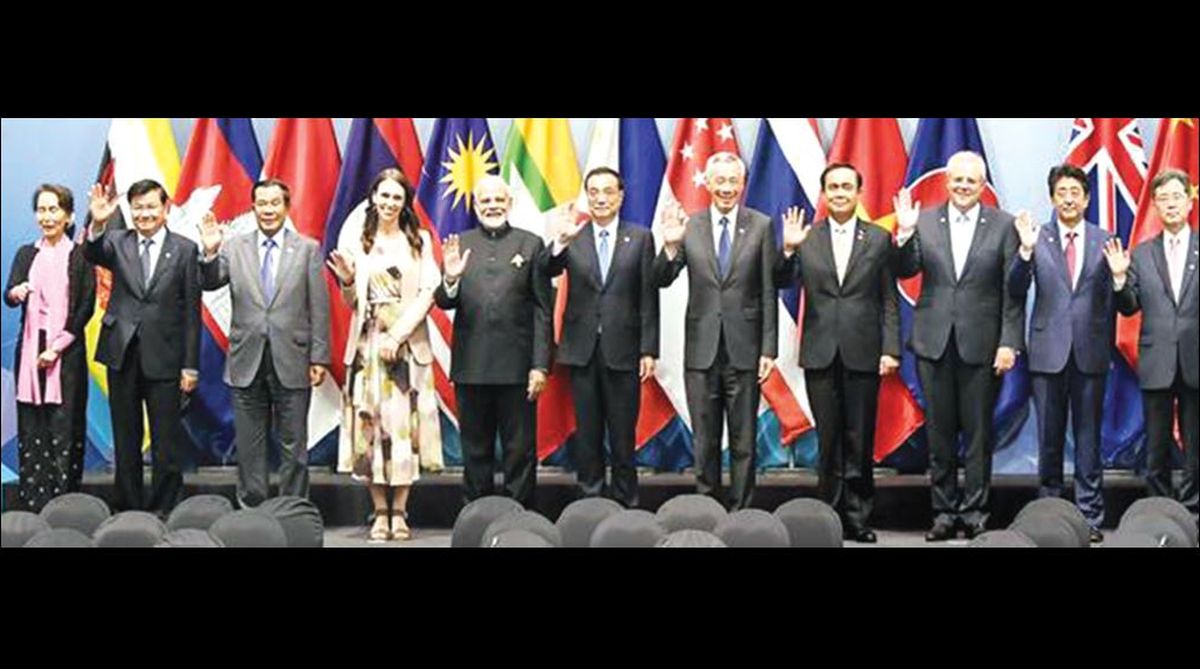India is now in a bind of its own in terms of keeping its trading of goods, services and investment interest gainfully secured through joining the Regional Comprehensive Economic Partnership Agreement (RCEP).
Indubitably, a modern, comprehensive, high-quality and mutually beneficial economic partnership agreement for an open trade and investment environment in the Asia-Pacific region will help expand regional trade and investment to contribute to global economic growth and development.
Advertisement
Countries in diverse development stages from Australia, China, Japan and India to the 10 members of the Association of South East Nations (Asean) are part of RCEP, besides South Korea and New Zealand. Once wrapped up, RCEP would foster the largest regional trading bloc, making up 25 per cent of global GDP, 30 per cent of world trade and 26 per cent of cross-country foreign direct investment (FDI) flows the world over.
The latest round of parleys held in Singapore in the second week of November gave up the proposal of arriving at a basic agreement by the year-end to gain time to reach the goalpost by the end of 2019. With several ministries cautioning against cheap and well-nigh duty-free imports inundating domestic markets including steel and metal, pharma products, food processing and dairy, besides farm goods of diverse kind, the Modi government resorted to the time-tested tactic of asking an expert group, comprising the Centre for Regional Trade, the Indian Institute of Management(IIM) Bangalore and the Indian Council for Research on International Economic Relations (ICRIER) to undertake stakeholders’ consultations to come out with a report by the end of January 2019.
The interesting point is that after six years of the inception of the negotiations, a belated study is being commissioned by the authorities to mollify indigenous interests lest any concessions exchanged sans ground realities would decimate them, besides throwing the huge swathe of people from gainful occupation or preventing fresh recruits from joining the job market in these industries.
Launched in November 2012 by leaders of the 16 countries, the talks were ambling on and the latest joint leaders’ statement on the RCEP negotiations on November 14 in which Prime Minister Narendra Modi took part claimed “substantial progress” in negotiations in 2018. So far, as many as seven chapters in RCEP encompassing economic and technical cooperation, small and medium enterprises, customs procedures and trade facilitation, government procurement, institutional provisions and sanitary and phytosanitary measures and standards, technical regulations and conformity assessment procedures (STRACAP) had been concluded. But the crucial one on market negotiations bristles with reservations by India as it is not prepared to let its domestic industry be extirpated by the deluge of cheap goods from the other members, particularly China which is fiercely competitive.
Interestingly, the erstwhile tiger economies of Asean want India to eliminate tariffs or customs duties on about 90-92 per cent items that it trades with the countries with which India has an FTA that includes Asean and Japan. With the non-FTA partners – Australia, New Zealand and China – discussions are going on for removing duties on 80 per cent of the traded products. New Delhi has asked for 20 years’ deadline to end the duties but with China it seeks more time for removal of tariffs.
The need for seeking the long liberalisation phase with China is based on grim ground realities. A House Panel report on the impact of Chinese goods on Indian industry, tabled in the monsoon session of Parliament contended that “the impact of Chinese imports has been such that India is threatened to become a country of importers and traders with domestic factories either cutting down their production or shutting down completely… the country can ill-afford its industry including, micro, small and medium enterprises (MSMEs) to get annihilated”.
According to the report, the annual year-on-year growth in Chinese imports was about 9 per cent in 2013- 14 which had soared to 20 per cent in 2017-18. Trade deficit with China at $63 billion constitutes more than 40 per cent of India’s aggregate trade deficit. The Chinese goods itself constitute about one-sixth of all imports in terms of quantum in India. In the decade 2007-08 to 2017-18, there has been an increase in India’s exports to China by $2.5 billion only while its imports from China have zoomed by $50 billion during this period. With such implacable statistics, Indian trade envoys are naturally demanding that China should give more and we in turn would give China lower concessions and take a longer staging period, given the mammoth trade deficit with Beijing.
As the core of the marathon talks zero in on market access for goods, services and investment, India might have earned a reprieve from immediate danger to its sheltered domestic sectors from withering outright, thanks to the extended deadline to end-2019. But as 2019 is an election year in India, the outcome of which will determine whether the proposed RCEP would be concluded by the incumbent government or a new one, India can ill-afford to undertake structural reforms including correction of the much-delayed inverted duty structure wherein raw material import duty is higher than intermediates or finished products and liberalisation of the mining sector to spur domestic manufacturing and vastly cut down import of steel, coal, oil and a plethora of other minerals by encouraging indigenous production through its own ingenuity and enhancement in productivity.
The expedient need to be in a mega trading bloc is nowhere more crucial than at this juncture when the World Trade Organization (WTO), the multilateral trade body that in its earlier avatar as the General Agreement on Trade & Tariffs (GATT) propelled the post-war prosperity the world over, is faced with an existential crisis. The numerous multilateral trade deals under its charge have come to a halt over the past decade. A slew of trading nations has naturally pitched for regional or preferential free trade agreements (FTAs) among compact number of participants to exchange concessions and move ahead with gains accruing from such liberalised trade.
For India, which has not been in any meaningful regional trading arrangement but attempted to latch on to a few FTAs that had only brought resentment from local industries that could not compete with cheap imports from such trading partners, the enduring benefits of trade remain evanescent. Its own genre of South Asian Association of Regional Cooperation (Saarc) remained in limbo because of the persistently indifferent and at times hostile relations between the trade major India and the minnow Pakistan.
India’s mercantile misery is accentuated on the external sector as there has been trade war between majors the United States and China which began resorting to retaliatory trade measures, befouling the global trading atmosphere and generating a sort of psychosis for emerging economies to wade in the choppy waters of overseas markets that have abruptly become impermeable.
.As the WTO is not standing guard to watch trade-distortive measures being resorted to by big countries, many a country found it imperative to hike import duties on goods they found threatening their domestic industry. In this dismal scenario, New Delhi ought to act with tact lest it should lose its way or get marginalised in the mega trade deals to its own lasting detriment.
The writer is a senior economic journalist based in New Delhi. He can be reached at geeyes34@gmail.com











